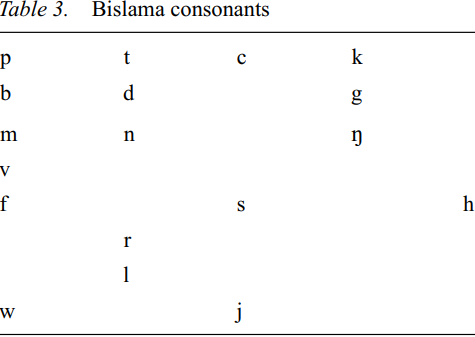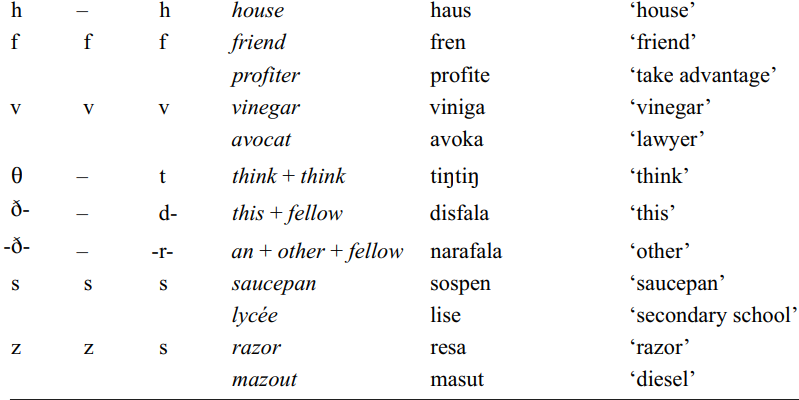


 Grammar
Grammar
 Tenses
Tenses
 Present
Present
 Past
Past
 Future
Future
 Parts Of Speech
Parts Of Speech
 Nouns
Nouns
 Verbs
Verbs
 Adverbs
Adverbs
 Adjectives
Adjectives
 Pronouns
Pronouns
 Pre Position
Pre Position
 Preposition by function
Preposition by function 
 Preposition by construction
Preposition by construction
 Conjunctions
Conjunctions
 Interjections
Interjections
 Grammar Rules
Grammar Rules
 Linguistics
Linguistics
 Semantics
Semantics
 Pragmatics
Pragmatics
 Reading Comprehension
Reading Comprehension|
Read More
Date: 2024-03-11
Date: 2024-04-17
Date: 2024-06-22
|
Table 3 sets out the consonants which can be shown to contrast in Bislama.

This inventory represents something of a mesolectal variety which is quite widely distributed among speakers of Bislama throughout Vanuatu. As will be demonstrated, there are some variations to this phoneme inventory.
These segments once again have phonetic realizations by and large that are suggested by the IPA values. The liquid represented as /r/ is phonetically normally an alveolar flap, though an occasional trilled articulation can be heard as a free variant. Some speakers produce instead a retroflex flap for this sound, though this is a strongly stigmatized pronunciation associated with speakers of particular local languages. The symbol /j/ represents a palatal semi-vowel. Particular note should be made of the fact that /c/ is generally realized as a voiceless post-alveolar grooved affricate, i.e. [ʧ] , though there is often a slightly fronted realization, i.e. [ts].
Words of vernacular origin tend to be adopted into Bislama with minimal change in shape, as the Bislama consonant inventory very closely resembles that of widely distributed vernacular patterns. With a consonant inventory that is substantially reduced vis-à-vis those of English and French, however, we find that a number of contrasts are systematically merged in Bislama. In particular, the English contrasts between /s/, /z/, /ʃ/ and /Ʒ/ are merged as /ð/, e.g. /sain/ ‘sign’, ‘shine’, /resa/ ‘razor’. The contrasts between /t/ and /θ/ on the one hand and /d/ and /D/ on the other are merged as /t/ and /d/ respectively, e.g. /tin/ ‘tin’ and /tiŋtiŋ/ ‘think’, /dis/ ‘dish’ and /disfala/ ‘this (< this + fellow)’. The contrast between voiced and voiceless segments is lost word-finally in Bislama, with only voiceless segments being found. Thus, the contrast between English dog and dock results in the homophonous form /dok/ meaning ‘dog’ and ‘warehouse (< dock)’ in Bislama.
The main patterns of correspondence between consonantal contrasts in standard English and French on the one hand and Bislama on the other are set in Table 4, along with illustrations of each pattern (with an English etymon presented first and a French etymon presented second).



Note that with respect to French words containing /ɲ/, forms have only been attested as being incorporated into Bislama in which this segment appears word-finally, e.g. champagne. Note also that the correspondences presented above for /r/ hold up despite the substantial phonetic difference between this liquid in the three languages. Finally, words beginning with /j-/ are extremely rare in French and none of these have been incorporated into Bislama, hence the lack of examples above.
While it is often possible to predict by these fairly regular correspondence statements what form a word of English origin will take in Bislama, there is by no means a completely regular set of correspondences. Thus, while English /ʧ/ generally corresponds to Bislama /c/ as in /cec/ ‘church’, the form /sakem/ ‘throw (< chuck)’ is idiosyncratically reflected as /s/. Also, while English /r/ is the primary source of /r/ in Bislama, there are some forms in which Bislama intervocalic /r/ unexpectedly derives from a number of other sounds, as in /griri/ ‘greedy’ (where /-d-/ is reflected as /-r-/ rather than /-d-/) and /wora/ ‘water’ (where /-t-/ is reflected as /-r-/ rather than /-t-/). However, it is certainly not the case that all instances of intervocalic /-d-/ and /-t-/ in English can be reflected with /-r-/ in Bislama, as evidenced by invariant forms such as /hotel/ ‘hotel’ and /lada/ ‘ladder’.
|
|
|
|
دراسة يابانية لتقليل مخاطر أمراض المواليد منخفضي الوزن
|
|
|
|
|
|
|
اكتشاف أكبر مرجان في العالم قبالة سواحل جزر سليمان
|
|
|
|
|
|
|
اتحاد كليات الطب الملكية البريطانية يشيد بالمستوى العلمي لطلبة جامعة العميد وبيئتها التعليمية
|
|
|